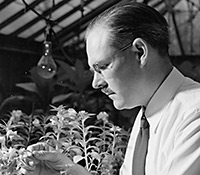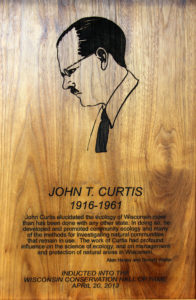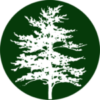1913 – 1961
Inducted 2013
“John Curtis elucidated the ecology of Wisconsin more than has been done with any other state. In doing so, he developed and promoted community ecology and many of the methods for investigating natural communities that remain in use. The work of Curtis had profound influence on the science of ecology, and on management and protection of natural areas in Wisconsin.” — Alan Haney and Donald Waller
 John Curtis was born in Waukesha, Wisconsin, in 1913. He received an A.B. from Carroll College in I934 and a Ph.D in botany from the UW-Madison in 1937. He remained on the faculty at UW-Madison for his entire career. He was recognized as a Guggenheim Fellow in 1942 and in 1951. Curtis was interested in the preservation of natural ecosystems, and was chairman of the Wisconsin State Board for Preservation of Scientific Areas, precursor to the state Natural Areas Commission, from 1952-1955. Wisconsin now has over 300 state natural areas. During his tenure at Madison, 39 students completed Ph.D.’s, many of them advancing to become distinguished ecologists in their own right.
John Curtis was born in Waukesha, Wisconsin, in 1913. He received an A.B. from Carroll College in I934 and a Ph.D in botany from the UW-Madison in 1937. He remained on the faculty at UW-Madison for his entire career. He was recognized as a Guggenheim Fellow in 1942 and in 1951. Curtis was interested in the preservation of natural ecosystems, and was chairman of the Wisconsin State Board for Preservation of Scientific Areas, precursor to the state Natural Areas Commission, from 1952-1955. Wisconsin now has over 300 state natural areas. During his tenure at Madison, 39 students completed Ph.D.’s, many of them advancing to become distinguished ecologists in their own right.
John Curtis is arguably best known for his seminal book, The Vegetation of Wisconsin: An Ordination of Plant Communities (1959). This book assembled a remarkably complete picture of the state’s plant communities and their relation to environmental variables based on data that he and his students collected from more than 1000 sites. In addition to detailed descriptions and interpretations of the natural communities of Wisconsin, this book presents convincing support for the idea that plant species respond in separate and continuous ways to underlying gradients in environmental conditions. Curtis became famous for this “continuum” concept of ecological gradients and for pioneering new statistical methods to investigate community structure and these responses. His work also established the nature of the prairie-forest border in Wisconsin and gave recognition to the “tension zone” where the interaction of climate, soil type, and fire create a dynamic transition. The data he and his students carefully archived are also providing a valuable baseline for tracking patterns of ecological change in the 21st century.
 At Madison, Curtis picked up on the idea for the Arboretum that was begun by Aldo Leopold (WCHF Inductee). Building on the goal of restoring representative natural communities on cropland near campus, he championed the concept of community restoration rather than collections of species as is more typical of arboretums. Indeed, it was Curtis who did much to shift the focus of ecological research from species (autecology) to communities (synecology), and established UW-Madison as leading school of ecology. The subdiscipline of restoration ecology has largely grown from Curtis’ early work on community ecology. Among his specific contributions, Curtis did research on prescribed fire as a tool to restore prairie. Prescribed fire is now one of the most widely employed approaches in ecological management. Madison continues to be a center for restoration ecology.
At Madison, Curtis picked up on the idea for the Arboretum that was begun by Aldo Leopold (WCHF Inductee). Building on the goal of restoring representative natural communities on cropland near campus, he championed the concept of community restoration rather than collections of species as is more typical of arboretums. Indeed, it was Curtis who did much to shift the focus of ecological research from species (autecology) to communities (synecology), and established UW-Madison as leading school of ecology. The subdiscipline of restoration ecology has largely grown from Curtis’ early work on community ecology. Among his specific contributions, Curtis did research on prescribed fire as a tool to restore prairie. Prescribed fire is now one of the most widely employed approaches in ecological management. Madison continues to be a center for restoration ecology.
John Curtis elucidated the ecology of Wisconsin more than has been done with any other state. In doing so, he developed and promoted community ecology and many of the methods for investigating natural communities that remain in use. Continuation of the work at the Arboretum begun by Aldo Leopold gave rise to the sub-discipline of restoration ecology and the importance of protection of unique natural reference areas. The work of Curtis had profound influence on the science of ecology, and on management and protection of natural areas in Wisconsin.
Resources
John Curtis – The Original Restoration Ecologist, UW Alumni Park website
John Curtis – The original restoration ecologist, article by Wendy Hathaway in OnWisconsin, 2019
Resoultions of Respect – John T. Curtis, from the Bulletin of Ecological Society of America, 1961
John Curtis Forms a New Institution: UW’s Plant Ecology Laboratory, University of Wisconsin Plant Ecology Laboratory
John T. Curtis – Fifty Years of Wisconsin Plant Ecology, The Wisconsin Academy of Sciences, Arts & Letters
